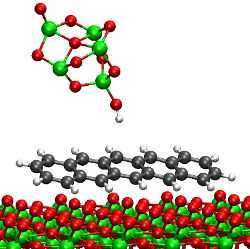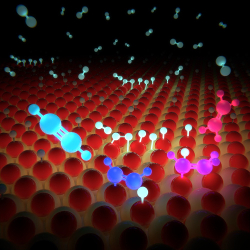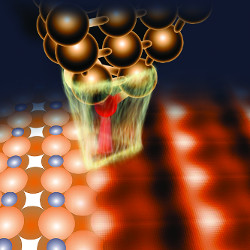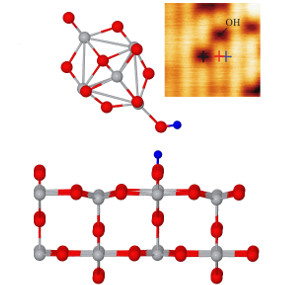SPM-TH
Scanning Probe Microscopy Theory & Nanomechanics GroupForces and Transport in Nanostructures
Research Activities
Oxide nanostructures for catalysis and energy applications
Nowadays there is a growing interest in studying the fundamental physics and chemistry of the surfaces of reducible oxides, as this knowledge can help optimizing or even finding new technological applications. We are currently doing research on two representative and technologically relevant oxides: TiO2 and CeO2. Cerium Oxide (Ceria, CeO2) is a technologically important material with applications in fields as diverse as catalysis, solid-oxide fuel cells, and biomedicine. Titanium dioxide (TiO2) is used in a broad range of applications, e.g. light harvesting, catalysis, surface coating, gas sensing, and medical implants.
Surface characterization and Defect identification on the clean and functionalised anatase TiO2 (101) surface
 |
Optoelectronic activity combined with high charge mobility make conjugated molecules and the TiO2 anatase polymorph materials of interest for prospective organic solar cells. We turn to first-principles simulation techniques in combination with NC-AFM/STM imaging and characterisation of pentacene molecules on the (101) surface of TiO2 anatase to gain insight into how these materials interact. We are also studying the contrast formation mechanisms of AFM and STM imaging for this surface and the interactions of the SPM probes [1] with small surface defects and adsorbates. Project members: M. Todorovic, R. Pérez.External collaboration: O. Stetsovych (Charles University, Czech Republic), C. Moreno (NIMS, Japan), O. Custance, (NIMS Japan) |
Redox properties and catalytic activity of CeO2 surfaces
 |
The basic process underlying the redox chemistry of ceria is the facile change in the oxidation state of the cerium ions (Ce4+ -> Ce3+). Standard exchange-correlation functionals fail to describe the spatial localization of the Ce 4f states and more sophisticated methods like DFT+U and hybrid functionals are required. We are particularly interested in combining first principles calculations, standard catalytic tests and SPM experiments in order to understand the catalytic activity of ceria for (1) the production of hydrogen through the water-gas-shift reaction [1]; and (2) the recently reported unique efficiency and selectivity in the partial hydrogenation of alkynes [2]. Project members: K. Kosmider, D. Fernández-Torre, R. Pérez.External collaboration: M. V. Ganduglia-Pirovano (ICP-CSIC, Madrid) and J. Carrasco (CIC Energygune, Vitoria); G. Vile and J. Pérez-Ramírez (ETH Zurich, Switzerland); O. Custance (NIMS, Japan) |
Understanding simultaneous AFM & STM imaging of metal oxides: the Cu-O (100) and (110) oxide surfaces
 |
Concurrent NC-AFM and STM imaging is a novel experimental technique that aims to achieve comprehensive functional imaging by recording both the chemical and electrical response of the surface. We team up with experimental parters to clarify the atomistic mechanisms behind a variety of imaging modes available for a model metal oxide surface, Cu-O: the characteristic arrangement of Cu and O atoms provides an ideal testbed for developing the capabilities of this experimental method. Our work revealed that frequent tip modifications occur with this technique [1], which led us to consider imaging modes as a function of tip chemistry [2] as well as tip transformation mechanisms. Project members: D. Rodríguez Hermoso, M. Todorovic, R. Pérez.External collaboration: U.D. Schwarz (Yale University, USA), E.I. Altman (Yale University, USA), H. Moenig (University of Muenster, Germany), M. Z. Baykara (Bilkent University, Turkey) |
Force Spectroscopy, Tip identification and Kelvin Probe Force Microscopy on the rutile TiO2 (110) surface
 |
An atomic-scale understanding of the surface properties and chemistry of TiO2 is essential to enhance its industrial applications. At variance with the usual STM studies, we have focused on the interpretation of the AFM images of the bare rutileTiO2(110) surface and in the presence of single metal adsorbates (K, Pt) that modify the surface electronic properties. We have combined site-specific force measurements with our first-principles calculations in order to clarify the origin of the force contrast and to characterize the tip structures responsible for the rich variety AFM imaging modes [1]. Using these tip models, we are currently studying the information obtained in Kelvin Probe Force Microscopy experiments. Project members: D. Fernández-Torre, R. Pérez.External collaboration: A. Yurtsever, Y. Sugimoto, S. Morita (Osaka University, Japan). |